Sauerkraut - Sauerkraut Weight Loss
Sauerkraut (/'sa??rkra?t/; German pronunciation: ['za?.??k?a?t]), directly translated: "sour cabbage", is finely cut cabbage that has been fermented by various lactic acid bacteria, including Leuconostoc, Lactobacillus, and Pediococcus.
It has a long shelf life and a distinctive sour flavor, both of which result from the lactic acid that forms when the bacteria ferment the sugars in the cabbage.
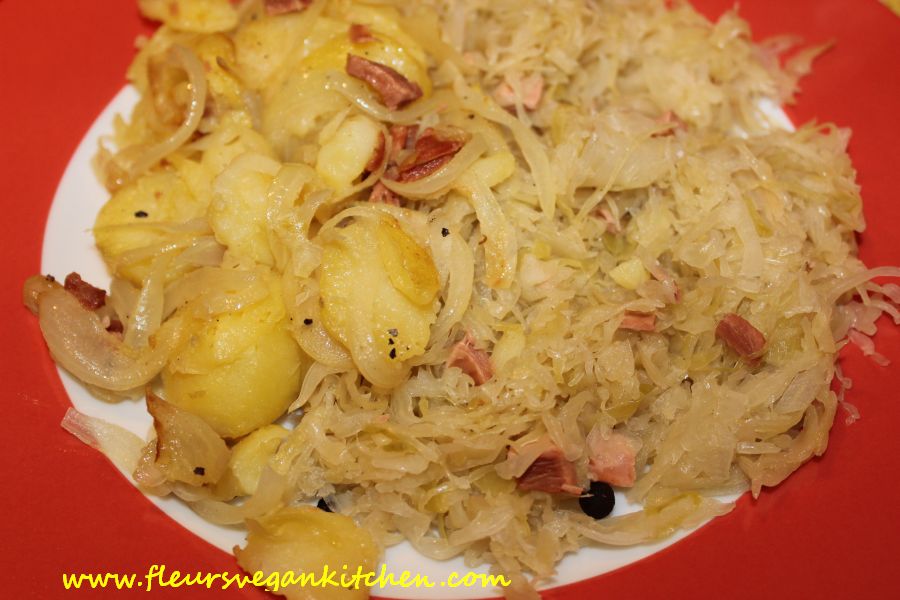
History
Fermented foods have a long history in many cultures, with sauerkraut being one of the most well-known instances of traditional fermented moist cabbage side dishes. The Roman writers Cato (in his De Agri Cultura) and Columella (in his De re Rustica) mentioned preserving cabbages and turnips with salt. It is believed to have been introduced to Europe in its present form 1,000 years later by Genghis Khan after invading China. The Tatars took it in their saddlebags to Europe. There it took root mostly in Eastern European and Germanic cuisines, but also in other countries including the Netherland, where it is known as zuurkool, and France, where the name became choucroute.
Before frozen foods, refrigeration, and cheap transport from warmer areas became readily available in northern, central and eastern Europe, sauerkraut, like other preserved foods, provided a source of nutrients during the winter. James Cook always took a store of sauerkraut on his sea voyages, since experience had taught him it prevented scurvy.
During World War I, due to concerns the American public would reject a product with a German name, American sauerkraut makers relabeled their product as "Liberty cabbage" for the duration of the war.
During World War I, British and Commonwealth forces used the word Kraut, derived from the dish, as a derogatory term for the German people. During World War II, the term was picked up by American Forces.
Geographic distribution
Sauerkraut has been known as far back as the 9th century in eastern Europe, the time of the import of cabbage from Byzantium. In Belarusian, Russian and Ukrainian cuisine, chopped cabbage is usually pickled together with shredded carrots. Other ingredients may include apples or cranberry. The resulting sauerkraut salad is typically served cold, as a zakuski or a side dish.
Sauerkraut is used as a filling for Polish pierogi, Ukrainian varenyky, Russian pirogi and pirozhki. Sauerkraut is also the most important ingredient in traditional soups, such as shchi (a national dish of Russia), kapusniak (Poland and Ukraine), kwa?nica (Poland), kapustnica (Slovakia), and zel?a?ka (Czech Republic). It is a common ingredient of Polish bigos (a hunter's stew).
In Germany, sauerkraut is often flavored with juniper berries. Traditionally it is served warm, with pork (e.g. eisbein, schweinshaxe, Kassler) or sausages (smoked or fried sausages, Frankfurter Würstchen, Vienna sausages, black pudding), accompanied typically by roasted or steamed potatoes or dumplings (knödel or schupfnudel). Similar recipes are common in other Central European cuisines. The Czech national dish vep?o knedlo zelo consists of roast pork with knedliky and sauerkraut.
Sauerkraut is the main ingredient of the Alsatian meal choucroute garnie (French for "dressed sauerkraut"), sauerkraut with sausages (Strasbourg sausages, smoked Morteau or Montbéliard sausages), charcuterie (bacon, ham, etc.), and often potatoes.
Sauerkraut, along with pork, is eaten traditionally in Pennsylvania on New Years Day. The tradition, started by the Pennsylvania Dutch, is thought to bring good luck for the upcoming year. Sauerkraut is also used in American cuisine as a condiment upon various foods, such as sandwiches and hot dogs.
Production
Sauerkraut is made by a process of pickling called lacto-fermentation that is analogous to how traditional (not heat-treated) pickled cucumbers and kimchi are made. The cabbage is finely shredded, layered with salt and left to ferment. Fully cured sauerkraut keeps for several months in an airtight container stored at 15 °C (60 °F) or below. Neither refrigeration nor pasteurization is required, although these treatments prolong storage life.
Fermentation by lactobacilli is introduced naturally and biologically, as these air-borne bacteria culture on raw cabbage leaves where they grow. Yeasts also are present, and may yield soft sauerkraut of poor flavor when the fermentation temperature is too high. The fermentation process has three phases, collectively sometimes referred to as population dynamics. In the first phase, anaerobic bacteria such as Klebsiella and Enterobacter lead the fermentation, and begin producing an acidic environment that favours later bacteria. The second phase starts as the acid levels become too high for many bacteria, and Leuconostoc mesenteroides and other Leuconostoc spp. take dominance. In the third phase, various Lactobacillus species, including L. brevis and L. plantarum, ferment any remaining sugars, further lowering the pH. Properly cured sauerkraut is sufficiently acidic to prevent a favorable environment for the growth of Clostridium botulinum, the toxins of which cause botulism.
A 2004 genomic study found an unexpectedly large diversity of lactic acid bacteria in sauerkraut, and that previous studies had oversimplified this diversity. Weissella was found to be a major organism in the initial, heterofermentative stage, up to day 7. It was also found that Lactobacillus brevis and Pediococcus pentosaceus had smaller population numbers in the first 14 days than previous studies had reported.
The Dutch sauerkraut industry found that inoculating a new batch of sauerkraut with an old batch resulted in an excessively sour product. This sourdough process is known as "backslopping" or "inoculum enrichment"; when used in making sauerkraut, first- and second-stage population dynamics, important to developing flavor, are bypassed. This is due primarily to the greater initial activity of species L. plantarum.
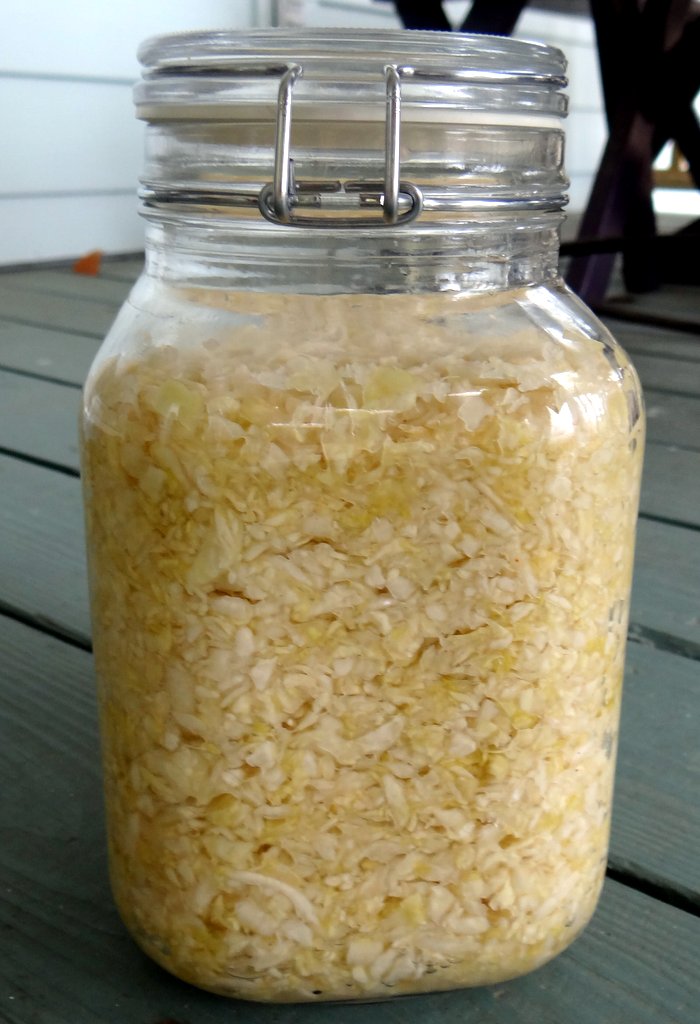
Health effects
Benefits
Many health benefits have been claimed for sauerkraut.
- It is a source of vitamins C, B, and K; the fermentation process increases the bioavailability of nutrients rendering sauerkraut even more nutritious than the original cabbage. It is also low in calories and high in calcium and magnesium, and it is a very good source of dietary fiber, folate, iron, potassium, copper and manganese.
- If unpasteurized and uncooked, sauerkraut also contains live lactobacilli and beneficial microbes and is rich in enzymes. The fiber and supply of probiotics improve digestion and promote the growth of healthy bowel flora, protecting against many diseases of the digestive tract.
- Sauerkraut has been used in Europe for centuries to treat stomach ulcers, and its effectiveness for soothing the digestive tract has been well established by numerous studies.
- Raw sauerkraut is distinctly different from store-bought, canned sauerkraut. While many food manufacturers can or jar their kraut using heat in order to extend shelf life, raw sauerkraut is lacto-fermented and is alive with good bacteria and probiotics. Raw sauerkraut is fermented over days or weeks at room temperature, packaged into jars with its own brine solution, then refrigerated to preserve the vitamins, enzymes, and beneficial bacteria without any heat. The lactic acid creates beneficial intestinal flora, balances stomach pH both directions, and helps break down proteins.
- During the American Civil War, the physician John Jay Terrell (1829-1922) was able to successfully reduce the death rate from disease among prisoners of war; he attributed this to the practice of feeding his patients raw sauerkraut.
- Sauerkraut is a time-honored folk remedy for canker sores. It is used by rinsing the mouth with sauerkraut juice for about 30 seconds several times a day, or by placing a wad of sauerkraut against the affected area for a minute or so before chewing and swallowing the kraut.
- The October 23, 2002 issue of the Journal of Agriculture and Food Chemistry reported that Finnish researchers found the isothiocyanates produced in sauerkraut fermentation inhibit the growth of cancer cells in test tube and animal studies. A Polish study in 2010 concluded that "... induction of the key detoxifying enzymes by cabbage juices, particularly sauerkraut, may be responsible for their chemopreventive activity demonstrated by epidemiological studies and in animal models".
- Sauerkraut is high in the antioxidants lutein and zeaxanthin, both associated with preserving ocular health.
Disadvantages
Excessive consumption of sauerkraut may lead to bloating and flatulence due to the trisaccharide raffinose, which the human small intestine cannot break down.

Gallery

Similar foods
Many other vegetables are preserved by a similar process:
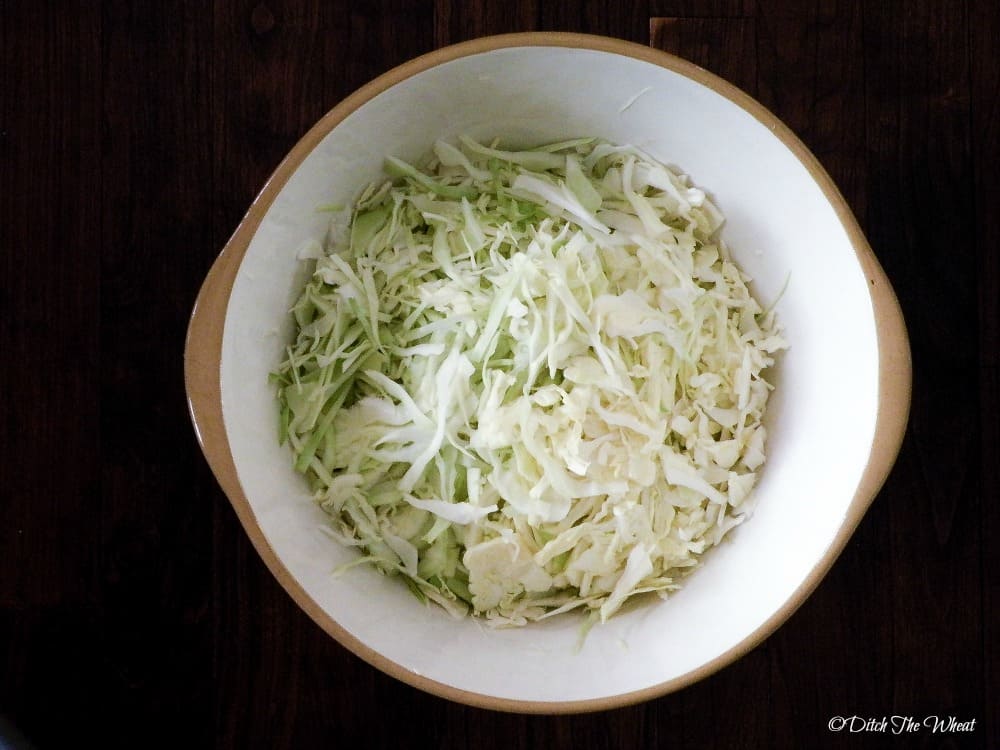
See also
- Foods containing tyramine
- List of fermented foods
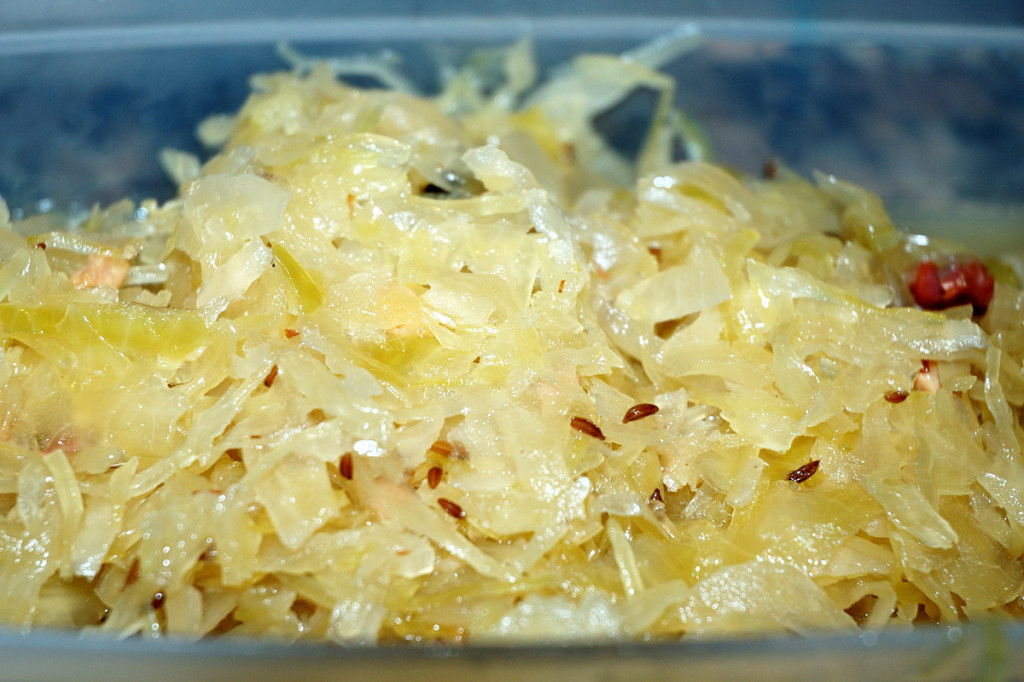
References
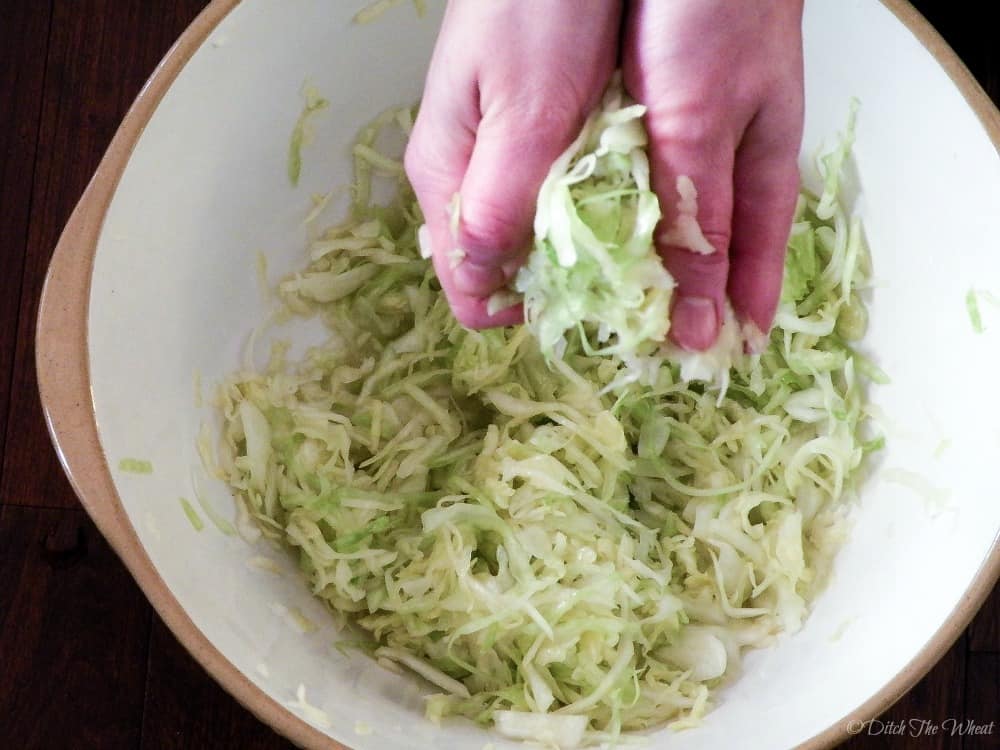
Bibliography
- USDA Canning guides, Volume 7
- "rec.foods.preserving FAQ". Retrieved 2006-04-23.
- Aubert, Claude (1999). Keeping Food Fresh: Old World Techniques & Recipes. Chelsea Green Publishing Company. ISBN 1-890132-10-1.
- Fallon, Sally, with Enig, Mary G., Ph.D. (2001). Nourishing Traditions...[westonaprice.org; newtrendspublishing.com]. New Trends Publishing. ISBN 0-9670897-3-5.
- Katz, Sandor Ellix (2003). Wild Fermentation: The Flavor, Nutrition, and Craft of Live-Culture Foods. Chelsea Green Publishing Company. ISBN 1-931498-23-7. Retrieved 2006-04-23.
- Kaufmann, Klaus (2001). Making Sauerkraut and Pickled Vegetables at Home. Book Publishing Company. ISBN 978-1-55312-037-7.
External links
- Media related to Sauerkraut at Wikimedia Commons
- Laboratory Exercise in Sauerkraut Fermentation
- Fermenting food since before H. sapiens appeared. The American Journal of Clinical Nutrition
- Crunchy pickled cabbage: video-tutorial
Interesting Informations
Looking products related to this topic, find out at Amazon.com
Source of the article : here












0 komentar :
Your comments